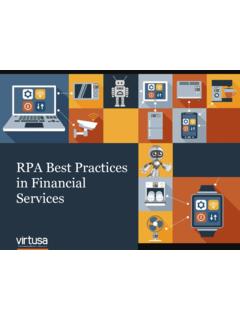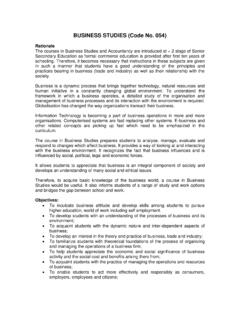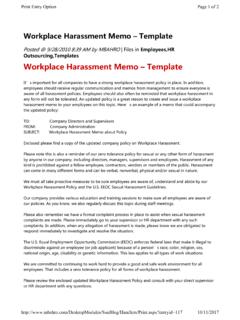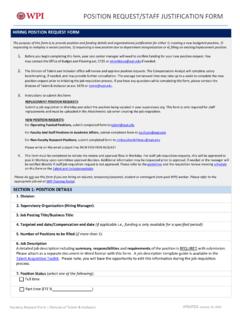Transcription of Robotic Process Automation - IRPAAI
1 Copyright 2015 by the Institute for Robotic Process AutomationINTRODUCTION TOROBOTIC PROCESSAUTOMATIONA PrimerDeveloped and written by the Institute for Robotic Process Automation in association with Carnegie Mellon UniversityCONTENTSA Message from IRPA Founder Frank Casale: Hard Facts and Hype The Data and the Drama Behind Robotic Process Automation .. 021 Beyond Pressing a Button: The Automation of Automation .. 052 From Transactional to Analytical: The Upsides of Robotic Process Automation .. 093 The End of outsourcing ? The Call for a New Synergy.. 174 Welcome to the Future: Robotic Process Automation Is Here to Stay.. 215 Revving to Go: The Roadmap to RPA Success.. 256In Review: What to Take Away from RPA.
2 28 Join Our Network: Stay Informed and Keep Connected.. 30 References.. 33 Acknowledgments.. 341 Copyright 2015 by the Institute for Robotic Process AutomationA MESSAGE FROM IRPA FOUNDER FRANK CASALEHARD FACTS AND HYPEThe Data and the Drama Behind Robotic Process AutomationImagine a world in which the meaning of work has been redefined for millions of people. Where ourservice economy can actually focus on providingservices, delivered by an engaged talent pool that isinnovating on such service. In this new world, work would no longer be a four-letter word associated withfunctioning within repeatable systems and mundane transactional processes. Instead, this other world wouldhave workers who rethink end-to-end processes on a more holistic level with the goal of simultaneouslyimpacting several factors: quality, compliance, functionality, best practices, regulatory functions, customersatisfaction, human error, and the all-important bottom line all while continuing to create the next inthe form of remarkable products and services.
3 If you ve come to this book, it s probably because someone you know has told you that, in fact, this isthe world we are already living in that 2015 is to Robotic Process Automation (RPA) what 1994 was tothe Internet an auspicious start, but we ain t seen nothing yet! Thanks to RPA, we are well on our way todoing the business of the future. However, none of us can really predict just how revolutionary it will 2015 by the Institute for Robotic Process Automation The mere mention of robots could conjure the worst nightmare of anyone who has read Aldous Huxleyor watched The Matrix, but science fiction s prediction that robots will become smarter than humans andmake them obsolete has no place here.
4 There s a lot of hype and paranoia regarding what RPA is capableof, now and in the future, and what it will mean for labor arbitrage. As Founder and CEO of The OutsourcingInstitute, I feel like this is d j vu all over again. In the early 1990s, I sensed that outsourcing was going tobe more than a passing trend, and despite its controversy, it became a pivotal strategy for companies seekingaccess to world-class capabilities and much-needed cost reductions. outsourcing s ability to have such adramatic impact on cost reduction would make implementation for most organizations a no-brainer. It wasapparent that as outsourcing grew, labor pools, locally and globally, would be impacted.
5 Some peoplepanicked, others were enraged, but no matter, the macro and micro economic effect was historical yes,controversial yes, political yes, stoppable no. And as we look to history to help us predict the future, we cannot deny that Automation , in particularrobotic Process Automation , is today s version of outsourcing unstoppable. And as industry leaders andemployees across all domains begin to run scared, there are many of us who are optimistic about the futureof work: there will always be work, just a very different kind. As human beings live longer and retire later, itmakes sense to work with RPA not necessarily to put workers on the unemployment line, but to retrain themin ways that makes sense for what we are capable of creating and producing in the 21st century.
6 By lookingto the future of work through the RPA lens, we can predict what kind of education, skills, and domains ourchildren should be committing to and preparing for what is inevitable Robotic Process Automation is hereto stay. In fact, there s no denying that Automation has been in our zeitgeist for quite some time from theautomated money counter that eliminated the bank teller s error in cashing your check to the food choicesavailable to you on an airline s menu to the locations programmed in the GPS of your car, Automation is notnew, but ever-evolving. And as we look tohistory to help uspredict the future,we cannot denythat Automation ;in particular, roboticprocess automationis today s versionof outsourcing unstoppable.
7 3 HARD FACTS AND HYPE: THE DATA AND THE DRAMA BEHIND Robotic Process AUTOMATIONC opyright 2015 by the Institute for Robotic Process Automation Will there be job casualties along the way? Absolutely. But the fact is, those companies that bury theirheads in the sand and don t make the pivot, either because they don t want to or don t know how to, willsuffer the same fate as the companies that just two decades ago didn t prepare for the shift to anoffshore/ outsourcing economy. This primer has been written to help you become informed on how you might prepare to make the pivot,to understand better what RPA does and will do in the future, and learn how it can affect the redesign ofprocesses and increase quality and value while decreasing costs.
8 Making the pivot to RPA is a decisive moment for service providers. The benefits of digital labor arerapidly eclipsing the benefits of physical labor, and service providers can choose or decline to translate thatinto success. I forecast that by 2020 as much as 40 percent of information technology outsourcing (ITO)andbusiness Process outsourcing (BPO) service providers will be out of business or acquired by largerenterprises, if they fail to embrace the change and reinvent their business models. For the buyer community, RPA is appealing because it is quick and cost effective and doesn t sendjobs offshore. It is my hope that our work at the Institute for Robotic Process Automation (IRPA), alongwiththe information in this primer, will help business leaders on both the buyer and service sides positionthemselves at the cutting-edge of knowledge work technology, turning what they thought was a dystopic humans need not apply ending into a utopic beginning for the future of : The benefits ofdigital labor arerapidly eclipsing thebenefits of physicallabor, and serviceproviders canchoose or declineto translate thatinto success.
9 4 HARD FACTS AND HYPE: THE DATA AND THE DRAMA BEHIND Robotic Process AUTOMATIONC opyright 2015 by the Institute for Robotic Process Automation1 Beyond Pressing a ButtonThe Automation of AutomationLabor Automation is anything but new. But what does Automation look like? What is the differencebetween what we ve seen robotically replace the work typically performed by human beings and roboticprocess Automation (RPA)? While we typically think of traditional Automation in terms of assembly linetechnology, ATMs, automated toll booths, and self-checkout counters, Robotic Process automationdeals with smart software and the application of smart software to do high-volume, repeatable tasks thatusually take humans an unbearable length of time to accomplish and which they typically find mundaneto perform.
10 One of the debates surrounding RPA revolves around the question of whether this technology is trulyrevolutionary or simply the product of the evolution of other similar technologies. Many technologies,includingartificial intelligence (AI), expert systems, and other methods of Process Automation have servedas predecessors to RPA. That being said, RPA takes artificial intelligence and expert systems to an elevatedlevel. Among leaders in the Automation industry, Robotic Process Automation is perceived as offering uniquecapabilities and advantages over previous Among leaders inthe automationindustry, roboticprocess automationis perceived asoffering uniquecapabilities andadvantagesover previoustechnologies.







